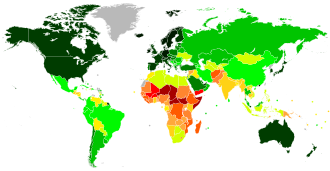Human Development Index
(Redirected from Human development index)
The Human Development Index (HDI) is a composite statistic of life expectancy, education, and per capita income indicators, which are used to rank countries into four tiers of human development. It was introduced by the United Nations Development Programme (UNDP) in 1990 as a measure of a country's social and economic development.
Components of the HDI
The HDI is calculated using three key dimensions:
1. Life Expectancy
This dimension measures the average number of years a newborn is expected to live if current mortality rates continue to apply. It reflects the ability of a country to provide a healthy and long life for its citizens.
2. Education
The education dimension is assessed by two indicators:
- Mean years of schooling: The average number of years of education received by people ages 25 and older, adjusted for the highest level of education attained.
- Expected years of schooling: The total number of years of schooling that a child of school entrance age can expect to receive if prevailing patterns of age-specific enrollment rates persist throughout the child's life.
3. Income
The income dimension is measured by Gross National Income (GNI) per capita. It reflects the standard of living and is adjusted for purchasing power parity (PPP) to account for differences in cost of living and inflation rates between countries.
Calculation of the HDI
The HDI is calculated as the geometric mean of normalized indices for each of the three dimensions. The formula is:
HDI = \( \sqrt[3]{\text{Life Expectancy Index} \times \text{Education Index} \times \text{Income Index}} \)
Each dimension index is calculated as follows:
\[ \text{Dimension Index} = \frac{\text{Actual Value} - \text{Minimum Value}}{\text{Maximum Value} - \text{Minimum Value}} \]
The maximum and minimum values are set by the UNDP to allow for comparability across countries.
Criticisms and Limitations
While the HDI is a widely used measure of development, it has several limitations:
- It does not account for inequalities, poverty, human security, and empowerment.
- It does not consider environmental sustainability.
- The HDI is a summary measure and may not capture the full complexity of human development.
Recent Developments
The UNDP has introduced additional indices to address some of the HDI's limitations, such as the Inequality-adjusted Human Development Index (IHDI), the Gender Development Index (GDI), and the Multidimensional Poverty Index (MPI).
Also see
- Inequality-adjusted Human Development Index
- Gender Development Index
- Multidimensional Poverty Index
- Gross National Income
- United Nations Development Programme
| Development of the human body | ||||||||
|---|---|---|---|---|---|---|---|---|
|
Transform your life with W8MD's budget GLP-1 injections from $125.
W8MD offers a medical weight loss program to lose weight in Philadelphia. Our physician-supervised medical weight loss provides:
- Most insurances accepted or discounted self-pay rates. We will obtain insurance prior authorizations if needed.
- Generic GLP1 weight loss injections from $125 for the starting dose.
- Also offer prescription weight loss medications including Phentermine, Qsymia, Diethylpropion, Contrave etc.
NYC weight loss doctor appointments
Start your NYC weight loss journey today at our NYC medical weight loss and Philadelphia medical weight loss clinics.
- Call 718-946-5500 to lose weight in NYC or for medical weight loss in Philadelphia 215-676-2334.
- Tags:NYC medical weight loss, Philadelphia lose weight Zepbound NYC, Budget GLP1 weight loss injections, Wegovy Philadelphia, Wegovy NYC, Philadelphia medical weight loss, Brookly weight loss and Wegovy NYC
|
WikiMD's Wellness Encyclopedia |
| Let Food Be Thy Medicine Medicine Thy Food - Hippocrates |
Medical Disclaimer: WikiMD is not a substitute for professional medical advice. The information on WikiMD is provided as an information resource only, may be incorrect, outdated or misleading, and is not to be used or relied on for any diagnostic or treatment purposes. Please consult your health care provider before making any healthcare decisions or for guidance about a specific medical condition. WikiMD expressly disclaims responsibility, and shall have no liability, for any damages, loss, injury, or liability whatsoever suffered as a result of your reliance on the information contained in this site. By visiting this site you agree to the foregoing terms and conditions, which may from time to time be changed or supplemented by WikiMD. If you do not agree to the foregoing terms and conditions, you should not enter or use this site. See full disclaimer.
Credits:Most images are courtesy of Wikimedia commons, and templates, categories Wikipedia, licensed under CC BY SA or similar.
Translate this page: - East Asian
中文,
日本,
한국어,
South Asian
हिन्दी,
தமிழ்,
తెలుగు,
Urdu,
ಕನ್ನಡ,
Southeast Asian
Indonesian,
Vietnamese,
Thai,
မြန်မာဘာသာ,
বাংলা
European
español,
Deutsch,
français,
Greek,
português do Brasil,
polski,
română,
русский,
Nederlands,
norsk,
svenska,
suomi,
Italian
Middle Eastern & African
عربى,
Turkish,
Persian,
Hebrew,
Afrikaans,
isiZulu,
Kiswahili,
Other
Bulgarian,
Hungarian,
Czech,
Swedish,
മലയാളം,
मराठी,
ਪੰਜਾਬੀ,
ગુજરાતી,
Portuguese,
Ukrainian
Contributors: Prab R. Tumpati, MD




